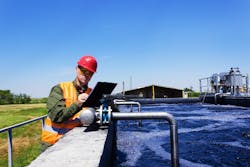Reducing potential downtime with wastewater treatment product storage and management best practices
Using coagulants and flocculants to remove suspended solids during industrial wastewater or influent surface water source treatment is common practice. However, failure to properly store or manage these chemicals can lead to downtime, impact production, increased costs, decreased equipment reliability and shortened lifespan, on-site safety issues and more.
For instance, poor water quality entering a process for boilers, cooling towers or process makeup can severely impact the reliability of the equipment, potentially leading to downtime or reduced output and impacting a facility’s bottom line. Similarly, if wastewater is improperly treated due to chemical feed, storage or supply issues, a facility risks violating wastewater discharge permit parameters, resulting in monetary fines and poor public relations.
Improperly stored and managed products used for water treatment can also lead to on-site safety issues for personnel tasked with the handling and the disposal of these products should their integrity become compromised and require replacement.
As such, it is important to ensure best practices on chemical storage and management are followed when putting together and executing an industrial water treatment program.
Storage basics for coagulants and flocculants
Understanding the characteristics of treatment chemicals is crucial to employing proper storage while building a successful treatment program.
Coagulants vary in chemistry type, each with different characteristics, such as viscosities, pour point and freeze point temperatures. Available storage containers, as well as feed and conveyance equipment, are important aspects of setting up a program. For example, while many coagulants have a relatively low viscosity and are easy to pump with standard chemical metering pumps, some higher-viscosity coagulants require specialized pumps to ensure proper dosing occurs.
Similarly, flocculants come in several forms (emulsion, powder, solution, etc.), each of which requires unique storage, handling and feeding needs to ensure optimal performance. Powder flocculants, for instance, should be stored in conditions that avoid moisture contamination.
The characteristics and capabilities of each product are also important when changing or reusing storage containers and tanks. Care must be taken to confirm if the new and old products are compatible, or if full removal of the existing product residual and container rinsing is needed. Container clean-out may be required, and supplier guidelines should be followed. Coagulants and flocculants often cannot be mixed, even with similar chemistries.
Product safety data sheets (SDS) often have key information on chemical characteristics. Still, the end user needs to work with the product supplier to ensure these factors are reviewed before implementing any program.
The end user’s environmental health and safety (EHS) policies on where and how to store coagulants and flocculants, government regulations and the purchaser and/or end-user’s company guidelines are critical to follow to ensure proper storage, use and safety.
Identify product use rates and inventory management
Another important consideration involves how much product to order at any given time to keep in inventory. For liquids stored in larger tanks, tank level sensors may be used to collect data on real-time product use and monitor inventory. This can be vital in inventory management and purchasing decisions. Full-service suppliers commonly work closely with customers to ensure the right amount of product is ordered.
Ensuring inventory levels are large enough that the product does not run out decreases the risk of requiring temporary water flow reduction through the system to meet discharge limits, short-term curtailment of water treatment or, in a worst-case scenario, reduced or loss of manufacturing production at the site. Products should be ordered to have enough on hand in case inlet water conditions change, which may drive up use rates.
In summary, coagulants and flocculants are commonly used to treat surface water and wastewater in various industries. Understanding how each product used should be stored, handled and applied is important to ensure the best treatment outcome.
Larry Smith is a senior customer applications engineer focusing on industrial water and wastewater treatment technical support for SUEZ - Water Technologies & Solutions. In his 43-year career, he has held positions in direct sales, technical marketing, engineering, product management and new project development support serving the North American heavy and light industrial marketplace.
About the Author
Larry Smith
Sr. Customer Applications Engineer, SUEZ – Water Technologies & Solutions
Larry Smith is a senior customer applications engineer with SUEZ – Water Technologies & Solutions.
